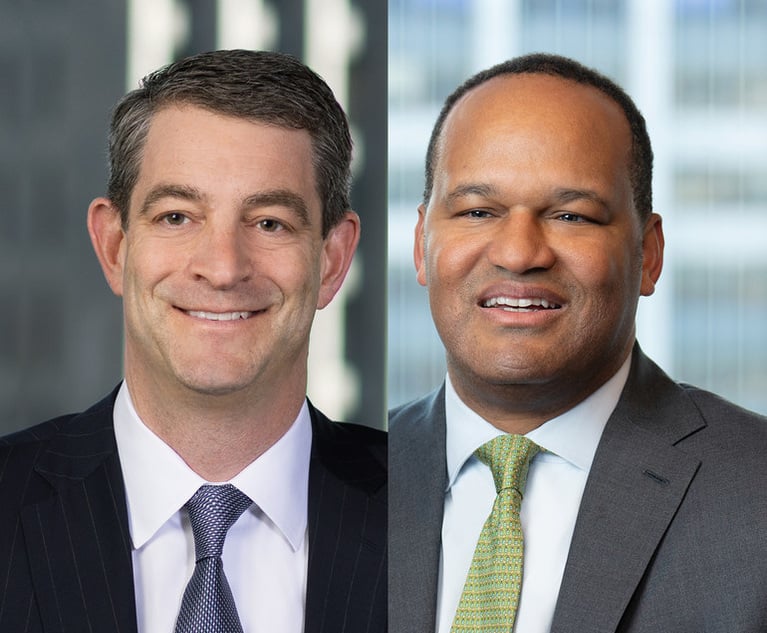Young Lawyers Are Stuck in the Middle of Law Firm Generation Gaps
As law firms face generational transitions, middle management faces its own challenge: navigating the culture clash.
April 16, 2020 at 12:39 PM
10 minute read
 Credit: MJgraphics/Shutterstock.com
Credit: MJgraphics/Shutterstock.com
Law firms are growing more generationally diverse every year. As more lawyers delay retirement until their 70s, baby boomers continue to represent a significant portion of the senior partnership at many major law firms. At the same time, the average age of law school graduates is 27, meaning that many junior associates today are millennials or members of Generation Z. The differences between these generations are too broad to be covered in this piece, but it suffices for present purposes to note that the individuals with the largest books of business at law firms often have very different outlooks on best workplace practices than the people carrying out the lion's share of the first-line work, who play an important role in realizing that business.
Middle managers—junior partners, counsel and senior associates—are increasingly called on to bridge these gaps. And they are stuck in what seems to be an impossible situation. Generally speaking, more senior generations bemoan attributes of the younger generation—such as being high maintenance and unwilling to just put their heads down and work as hard as needed, in the office, to get the job done. Junior attorneys, by contrast, want meaningful opportunities for professional development early in their careers and expect work-life balance and workplace flexibility at the outset.
In one moment, middle managers must serve as the face of change to a junior attorney, and in the next act as a subordinate conforming with the norms and expectations of senior leadership. Failure on either front is not an option. A loss of confidence from senior attorneys can be career-threatening. But so too is a loss of engagement from junior attorneys—worse work product coming in can result in a time-suck in which middle managers have to revise or redo work at higher billing rates. And attrition is even worse: When junior lawyers leave, middle management lawyers lose the most, including the time invested in training junior attorneys; the opportunity to use nonbillable time to develop business while skilled junior attorneys handle daily tasks; and the possibility of setting aside some time for themselves and their families. Here, we present points for consideration for the generations often pulling the middle managers in different directions.
Senior Lawyers Should Listen
For senior lawyers, some of the requests from younger generations may be hard to fathom. Why accommodate flexible work schedules? Why provide more vacation days? Why push untested junior lawyers for opportunities in high-stakes matters when there are more profits to be made by trusting more senior, battle-tested attorneys? Why give young lawyers more of a stake in firm decisions?
One part of the answer is that accommodating some of these requests is a necessary product of changing times, especially given advances in technology. It wasn't possible to telecommute or effectively address client questions from outside the office before the advent of email, instant messaging software and so on. Now that innovation has allowed people to work from virtually any place and at virtually any time, flexibility is possible and can result in increases in productivity and engagement.
Another part of the answer comes from the changing nature of legal practice. Clients today generally don't hire one firm to handle all their problems but engage the right people for the task, creating new levels of firm competition and more uncertainty about the future. It is understandable for junior lawyers to express concern about their firm's direction, skepticism and the desire to "look under the hood."
It's also important to note that acceding to some demands from younger attorneys is good for attorney and client development, and thus is good for the bottom line. Firms and law departments invest heavily in recruiting top talent, whether laterally or direct from law school or clerkships. Headhunters are expensive (typically costing law firms 20% of a recruit's annual pay or more), as is sending teams of lawyers to recruit students on campus (especially when it takes them away from billable work). The investment only grows once a lawyer joins the firm. In her first four years at a firm, an associate will earn over $1 million in salary and bonus combined, on top of other benefits, overhead and perks. Formal training is costly too. As just one example, sending a single associate to a weeklong trial-skills boot camp can cost well over $3,000. Custom in-house courses can come with much heftier price tags—not to mention opportunity costs. Mentoring and other forms of informal training represent an additional—sometimes more sizable—investment of time from senior lawyers.
With this investment, firms should want to not only retain lawyers (average associate attrition at big law firms is over 15% per year, with lawyers of color leaving their firms at a disproportionate rate) but also keep them happy so they are motivated to be engaged, work hard, develop creative ideas and cultivate strong client relationships. Satisfied lawyers are more likely to seek out and make the most of learning opportunities—leading a deal team, arguing in court and so on—which in turn allows them to develop essential skills that permit them to contribute meaningfully to matters.
Keeping lawyers happy and helping them develop their skills also translates into more satisfied clients. Most clients appreciate building relationships with associates and junior partners they can often trust to not only be more available than busy senior partners but also have the details of the client's business and matter at their fingertips. If those lawyers become disengaged, clients can lose confidence in the team overall, especially if that disengagement results in worse work product. Of course, the impact on the client is even worse when those go-to junior and mid-level lawyers leave. Not only have these clients lost a trusted resource, but they will be asked to foot the bill for a replacement to get up to speed and fill the gap. Conversely, when relatively junior lawyers are performing at their peak, clients reaps the benefits in terms of better work product and a more reliable resource at the firm. Happy clients are more likely to expand their relationship with the firm and come back with future business.
Junior Lawyers Need Perspective
None of the above is to say that law firms should simply do whatever junior associates ask. The practice of law is a business—which is something that younger attorneys often overlook. Everyone would like to get paid Big Law salaries for a 9-to-5 job that can be performed from anywhere, with exciting opportunities coming in for attorneys of all levels of seniority. But those unicorn jobs exist rarely, if anywhere.
One important quality for young lawyers to develop is patience. There is a big difference between senior attorneys taking every opportunity on cases and leaving only grunt work for junior attorneys, and senior attorneys staffing many of those opportunities to preserve client relationships and ensure that pipelines remain open for future lucrative work involving new attorneys. It is always a hard sell for clients to invest in newer and less tested legal talent, and if firms push too hard on that front, it may lead clients to look elsewhere or lose confidence in the firm's judgment.
Relatedly, there is something to be said for developing experience by spending time in the trenches and being visible within the office, within reason. From the client side, what law firms are selling is judgment—quality recommendations backed by quality reasoning. While good leaders and managers solicit feedback from all levels of an organization, judgment can often take time to develop and is best developed through experience. From the firm's perspective, decisions on who to promote to partner and other leadership roles are investment decisions—the firm is buying stock in a person. Like any good investment, it is reasonable for firms to have as much available data possible to ensure they are backing the right people.
How Do We Get It Done?
The clash of cultures isn't just an abstract debate—it also can pose challenges for middle managers in terms of assigning and completing work. Middle managers often face several competing pressures:
- Helping prepare and manage the docket of senior partners with large books of business;
- Finding opportunities to get on their feet themselves in front of clients and courts to get valuable experience and become more marketable; and
- Ensuring that junior attorneys build valuable skills and remain invested and engaged, which can often require advocating for them to get more advanced opportunities.
Just as it can hold middle managers back to be seen just as case organizers and behind-the-scenes players, so too can it be an obstacle for them to perpetually remain at lower rungs of new engagements.
How do these pressures play out in the billable hour model? Clients' economic incentives are to get the best results for the lowest cost. Firms, by contrast, want to maximize profits and maintain lucrative client relationships. The way in which these often-competing impulses resolve is with senior partners handling the majority of engagements, sometimes at slightly reduced rates, with occasional opportunities trickling down to be snapped up by slightly more junior lawyers eager to get on their feet. But this arrangement can often leave junior partners (and even more so, associates) in the cold, and can signal to younger lawyers that they can only get meaningful experience by leaving.
One remedy is for firms to view professional development as an asset in its own right. Firms can make this investment by declining to reduce rates for more senior partners to create natural pressure to spread opportunities down, giving discounts for opportunities for up-and-coming talent, writing off the costs of having younger attorneys attend key meetings and hearings to demonstrate their aptitude and value to the client, and pushing for clients to recognize younger and usually cheaper talent as show-ready. Alternative fee arrangements are also an asset on this front. Fixed fees, for example, dramatically reduce the cost to clients of broader attendance at key client meetings, hearings and other major inflection points. Clients see themselves as getting more bang for their buck. Together, these strategies can help produce a broader bench of attorneys ready to deliver positive results, which benefits firms as a whole.
Communication Is Key
It is clear, from our collective experience, that asking middle managers to attempt to bridge all these gaps themselves can set them up to fail, by holding back the lawyers who actually try to be good middle managers and manage both up and down, rather than those who simply manage up at all costs. One additional, partial solution is broadening the lines of communication between all levels of a firm. Single lines of communication are unlikely, at best, to promote broader workplace change and understanding. Letting more junior lawyers understand the thought process of firm leaders—whether by including more attorneys in prep sessions or providing more explanation for and insight into the decisions that are ultimately made—provides valuable professional guidance going forward.
When senior partners explain the business and client pressures they are facing to more junior attorneys, it can help minimize frustration and also potentially promote creative thoughts about ways to relieve those pressures. At the same time, junior lawyers should not feel afraid to speak up and seek out both explanations and opportunities at the right moments.
Middle managers are part of the solution for helping bridge these gaps and making sure that everyone rows in the same direction at the optimal speed, but the bottom line is that they cannot be the whole answer.
The views expressed here are personal to the authors and do not represent the opinions of their employers.
This content has been archived. It is available through our partners, LexisNexis® and Bloomberg Law.
To view this content, please continue to their sites.
Not a Lexis Subscriber?
Subscribe Now
Not a Bloomberg Law Subscriber?
Subscribe Now
NOT FOR REPRINT
© 2025 ALM Global, LLC, All Rights Reserved. Request academic re-use from www.copyright.com. All other uses, submit a request to [email protected]. For more information visit Asset & Logo Licensing.
You Might Like
View All
'None of Us Like It': How Expedited Summer Associate Recruiting Affects Law Students and the Firms Hiring Them

Latham's Lateral Hiring Picks Up Steam, With Firm Adding Simpson Practice Head, Private Equity GC
3 minute read

Leaning Into ‘Core’ Strengths, Jenner’s Revenue Climbs 17%, Profits Soar 23%
4 minute readTrending Stories
- 1Thursday Newspaper
- 2Public Notices/Calendars
- 3Judicial Ethics Opinion 24-117
- 4Rejuvenation of a Sharp Employer Non-Compete Tool: Delaware Supreme Court Reinvigorates the Employee Choice Doctrine
- 5Mastering Litigation in New York’s Commercial Division Part V, Leave It to the Experts: Expert Discovery in the New York Commercial Division
Who Got The Work
J. Brugh Lower of Gibbons has entered an appearance for industrial equipment supplier Devco Corporation in a pending trademark infringement lawsuit. The suit, accusing the defendant of selling knock-off Graco products, was filed Dec. 18 in New Jersey District Court by Rivkin Radler on behalf of Graco Inc. and Graco Minnesota. The case, assigned to U.S. District Judge Zahid N. Quraishi, is 3:24-cv-11294, Graco Inc. et al v. Devco Corporation.
Who Got The Work
Rebecca Maller-Stein and Kent A. Yalowitz of Arnold & Porter Kaye Scholer have entered their appearances for Hanaco Venture Capital and its executives, Lior Prosor and David Frankel, in a pending securities lawsuit. The action, filed on Dec. 24 in New York Southern District Court by Zell, Aron & Co. on behalf of Goldeneye Advisors, accuses the defendants of negligently and fraudulently managing the plaintiff's $1 million investment. The case, assigned to U.S. District Judge Vernon S. Broderick, is 1:24-cv-09918, Goldeneye Advisors, LLC v. Hanaco Venture Capital, Ltd. et al.
Who Got The Work
Attorneys from A&O Shearman has stepped in as defense counsel for Toronto-Dominion Bank and other defendants in a pending securities class action. The suit, filed Dec. 11 in New York Southern District Court by Bleichmar Fonti & Auld, accuses the defendants of concealing the bank's 'pervasive' deficiencies in regards to its compliance with the Bank Secrecy Act and the quality of its anti-money laundering controls. The case, assigned to U.S. District Judge Arun Subramanian, is 1:24-cv-09445, Gonzalez v. The Toronto-Dominion Bank et al.
Who Got The Work
Crown Castle International, a Pennsylvania company providing shared communications infrastructure, has turned to Luke D. Wolf of Gordon Rees Scully Mansukhani to fend off a pending breach-of-contract lawsuit. The court action, filed Nov. 25 in Michigan Eastern District Court by Hooper Hathaway PC on behalf of The Town Residences LLC, accuses Crown Castle of failing to transfer approximately $30,000 in utility payments from T-Mobile in breach of a roof-top lease and assignment agreement. The case, assigned to U.S. District Judge Susan K. Declercq, is 2:24-cv-13131, The Town Residences LLC v. T-Mobile US, Inc. et al.
Who Got The Work
Wilfred P. Coronato and Daniel M. Schwartz of McCarter & English have stepped in as defense counsel to Electrolux Home Products Inc. in a pending product liability lawsuit. The court action, filed Nov. 26 in New York Eastern District Court by Poulos Lopiccolo PC and Nagel Rice LLP on behalf of David Stern, alleges that the defendant's refrigerators’ drawers and shelving repeatedly break and fall apart within months after purchase. The case, assigned to U.S. District Judge Joan M. Azrack, is 2:24-cv-08204, Stern v. Electrolux Home Products, Inc.
Featured Firms
Law Offices of Gary Martin Hays & Associates, P.C.
(470) 294-1674
Law Offices of Mark E. Salomone
(857) 444-6468
Smith & Hassler
(713) 739-1250










